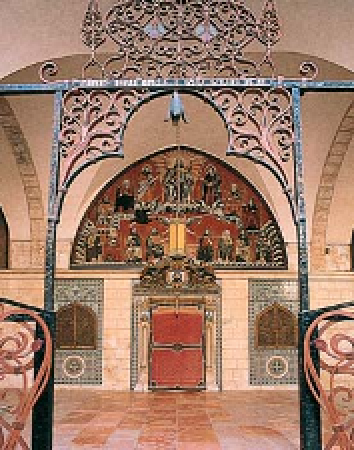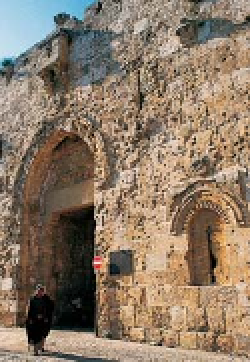Travel Reference
In-Depth Information
thickly laid with
Oriental rugs.
Four great square
piers divide the
main space into
three aisles. These
piers, along with
the walls, are
covered in blue-
and-white tiles
with floral and
abstract patterns.
In the apses at the
end of each of the
three aisles are
altars, separated
from the rest of
the church by the
iconostasis screen.
Two thrones stand
in the choir; the
one nearest the
pier is said to be
that of St James
the Less, traditionally held to
have been a step-brother of
Christ and the first bishop of
Jerusalem. It is used only once
a year, in early January, on the
occasion of his feast day. The
other throne is the one nor-
mally used by the patriarch.
The cathedral contains many
small shrines and chapels. The
third on the left as you enter
is the most important: it sup-
posedly holds the head of
St James the Great. Off to the
right, the Etchmiadzin Chapel
has some beautiful tiling.
churches unearthed near
Damascus Gate. The pride
of the museum is its collec-
tion of early manuscripts. In
addition, there are also a
great many liturgical objects,
many of which were donated
to St James's Cathedral by
Armenian pilgrims. There are
also examples of the pottery
for which the Armenians have
always been famous.
Other interesting objects
are examples of the first
topics printed in the first print
shop in Jerusalem, which has
been active since 1833 inside
the Armenian monastery.
Wrought-iron gate framing the ornate main
entrance to St James's Cathedral
St James's
Cathedral
e
Armenian Patriarchate Rd.
Map
3 B5.
Tel
(02) 628 2331.
l
#
6:30-7:30am &
3-3:40pm Sun-Fri, 6:30-9:30 am Sat.
The Armenian Cathedral is
one of the most beautiful
of all Jerusalem's sacred
buildings. It was originally
constructed in the 11th and
12th centuries over the reputed
tomb of St James the Great,
the Apostle, killed by Herod
Agrippa I (
Battle-scarred Zion Gate
Zion Gate
t
Map
3 C5.
( D 37-44). Many
alterations and additions
have since been made, most
notably in the 18th century,
when much of the existing
decoration was added.
Entrance to the cathedral is
via a small courtyard with a
19th-century fountain. On the
western wall of the courtyard
are inscriptions in Armenian,
one of which dates from
1151. Hanging in the
vaulted porch are
wooden bars. Each
afternoon a priest
strikes these with
a wooden mallet
known as a
nakus
,
to signal the start
of the service.
The cathedral
interior is enchant-
ing. It is only dimly
illuminated by a
forest of oil lamps hung from
the ceiling. There are no
seats; instead the floors are
Mardigian
Museum
r
Armenian Patriarchate Rd.
Map
3 B5.
Tel
(02) 628 2331.
l
Zion Gate was constructed
by Suleyman the Magnificent's
engineers
(see p105)
in 1540.
It allowed direct access from
the city to the holy sites on
Mount Zion. Fighting was
particularly fierce here in
1948, when Israeli soldiers
were desperate to breach the
walls to relieve the Jewish
Quarter inside, under siege by
the Jordanians. The outside of
the gate is terribly pockmarked
by bulletholes. A short diA -
tance to the west of the gate
there is conspicuous damage
to the base of the wall where
soldiers tried to blast their way
through with explosives.
In Arabic, the gate is known
as Bab el-Nabi Daud (Gate of
the Prophet David), because
of its proximity to the place
traditionally known as King
David's Tomb
(see p117)
.
#
10am-4:30pm
Mon-Sat.
&
Dating from 1863, this was
originally the seminary
of the nearby Armenian patri-
archate. It is now a
museum dedicated to
the history and cul-
ture of the Armenian
people. The building
is attractive, with a
long central courtyard
flanked by porticoes.
The oldest finds in the
collection are frag-
ments of 1st-century
frescoes from the
courtyard of the so-
called House of Caiaphas on
Mount Zion, and remains from
Byzantine-period Armenian
17th-century jug,
Mardigian Museum
For hotels in this area see p256










